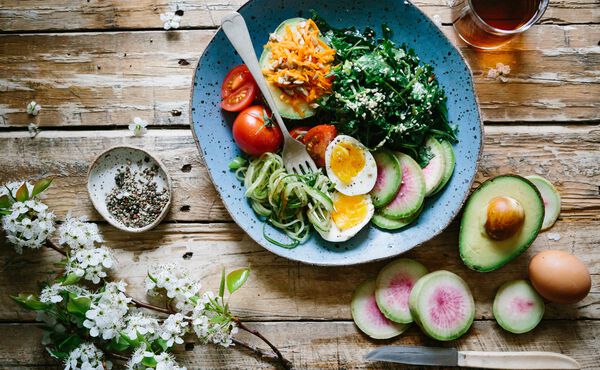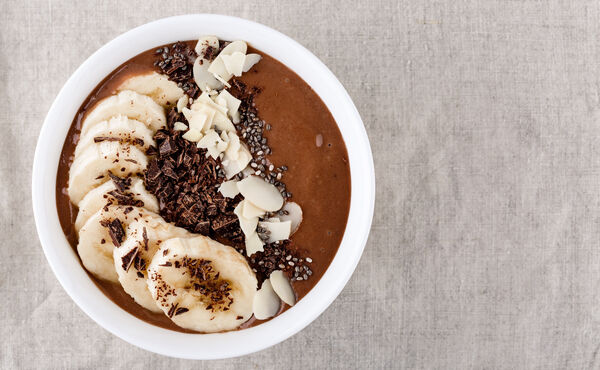We’ve all heard the expression, “you are what you eat.” But how much do you actually know about your food? We turn to expert Nigel van der Horst for some advice on how to create a healthy plate of food for ultimate nourishment.
Take a look at your plate. What do you see?
I’ll tell you what I see—I see nutrients. We should all start looking at what we eat a bit differently. But we can only do that if we have the basic knowledge about what’s in our food. That’s why I’d like to share some of this knowledge with you, so you can start making healthier decisions right away.
Carbohydrates: fuel for the body
Carbohydrates contain 4 kilocalories per gram and are mainly used by the body as fuel—including your brain and central nervous system. Carbohydrates are sometimes called sugars that we divide into two types: simple (monosaccharides or disaccharides) or complex (polysaccharides). Milk and milk products, fruit, candy, baked goods and white sugar are some examples of simple carbohydrates. Complex carbohydrates can be found in bread, grains, potatoes, legumes and vegetables.
Proteins: building blocks
Just like carbohydrates, proteins contain 4 kilocalories per gram and are very important for the body. They are the building blocks, necessary for building cell structure, muscle mass and for maintaining the muscular system. They’re also integral to hormone production, enzymes and neurotransmitters and cause a satiating effect. The amount and quality of proteins differs widely per product. Proteins mainly exist in animal products, such as meat, fish, milk, cheese and eggs. Plant-based products can also contain (relatively) a lot of protein: breed, (wholegrain) cereals, nuts, seeds and legumes (like soy).
Fat: it’s not all bad for you
Unlike carbohydrates or proteins, fat contains 9 kilocalories per gram. Fats give us energy, protect our internal organs against the cold and assist cell growth. Fats are categorized as saturated, unsaturated and essential fatty acids. Essential fatty acids are unsaturated fatty acids that the body cannot produce on its own, such as omega 3 (the fatty acid found in fish) and linoleic acid. Saturated fats are generally bad for your health because they elevate your cholesterol level. Unsaturated fat, however, actually has a positive effect on the circulatory system. You can find the most saturated fats in animal products as well as in cake, cookies and snacks. Unsaturated fatty acids are mostly in organic products like olive oil, nuts, seeds and pips, along with liquid baking and cooking products, fatty fish and avocado.
Fibres: the digestive system’s best friend
Fibres are plant-based nutrients that belong in the carbohydrate group but are not absorbed or digested by the small intestine. Fibres have a positive effect on the bowels as well as a satiating effect. Fibres are mostly found in vegetables, fruit, potatoes, bread, wholegrain cereals, legumes and nuts.
Vitamins and minerals and trace elements: health boosters
Unlike carbohydrates, proteins and fat, vitamins and minerals are not converted to energy. They are, however, essential for your health. They’re needed in micro amounts, but if you have a deficiency, this can cause lots of health issues: chronic tiredness, insomnia and concentration problems, just to name a few. In extreme cases, not ingesting enough can cause bone disorders and neurological issues. Vitamins, minerals and trace elements are present in all kinds of food, which is why dieticians used the word “variation” so much when they’re discussing them.
Your guidelines for a healthy plate
Now that you know a bit about all the nutrients that are present in your food, you can start thinking about building a healthy plate. Here are some basic guidelines:
- Carbohydrates: 3-4 grams per kg of body weight
- Protein: 1-1.5 grams per kg of body weight
- Fat: 0.8-1 gram of fat per kg of body weight
- Vegetables: 375-500 grams per day
- Fruit: 300 grams per day
This is what the body needs to maintain a healthy weight.
How to lose weight
A lot of people take the wrong approach when it comes to losing weight. They reduce their food intake severely and work out more, which produces an “energy hole” where you’re burning much more than you’re eating—this is impossible to do over a long period of time.
Instead, you should start by eating 300-500 fewer calories per day. Or, work out for an hour to burn those 300-500 calories. I don’t recommend doing both at the same time, as it becomes very difficult to maintain and the chance that you’ll revert back to your old ways out of frustration is big. You need to learn how to deal with it gradually: for example, for the first 2-3 weeks, try eating a ½ meal less. See how this goes and let your body adjust. Replace a high-calorie meal with a low-calorie one, eat earlier in the day and eat less at night. If you eat out a lot, remember that the portions you get at a restaurant are typically larger than what you have at home, so take that into account and eat a bit less the rest of the day or workout a bit more. It’s all about balance.
These aren’t huge adjustments—it’s about being conscious of what you’re doing and why you’re doing it. If you incorporate thee tips into your daily life, you’ll feel more comfortable in your own skin, make healthier choices and attain that perfect balance in your eating patterns.





.jpg?sw=600&sh=370&sm=fit&cx=655&cy=2492&cw=2739&ch=1689&sfrm=jpg)